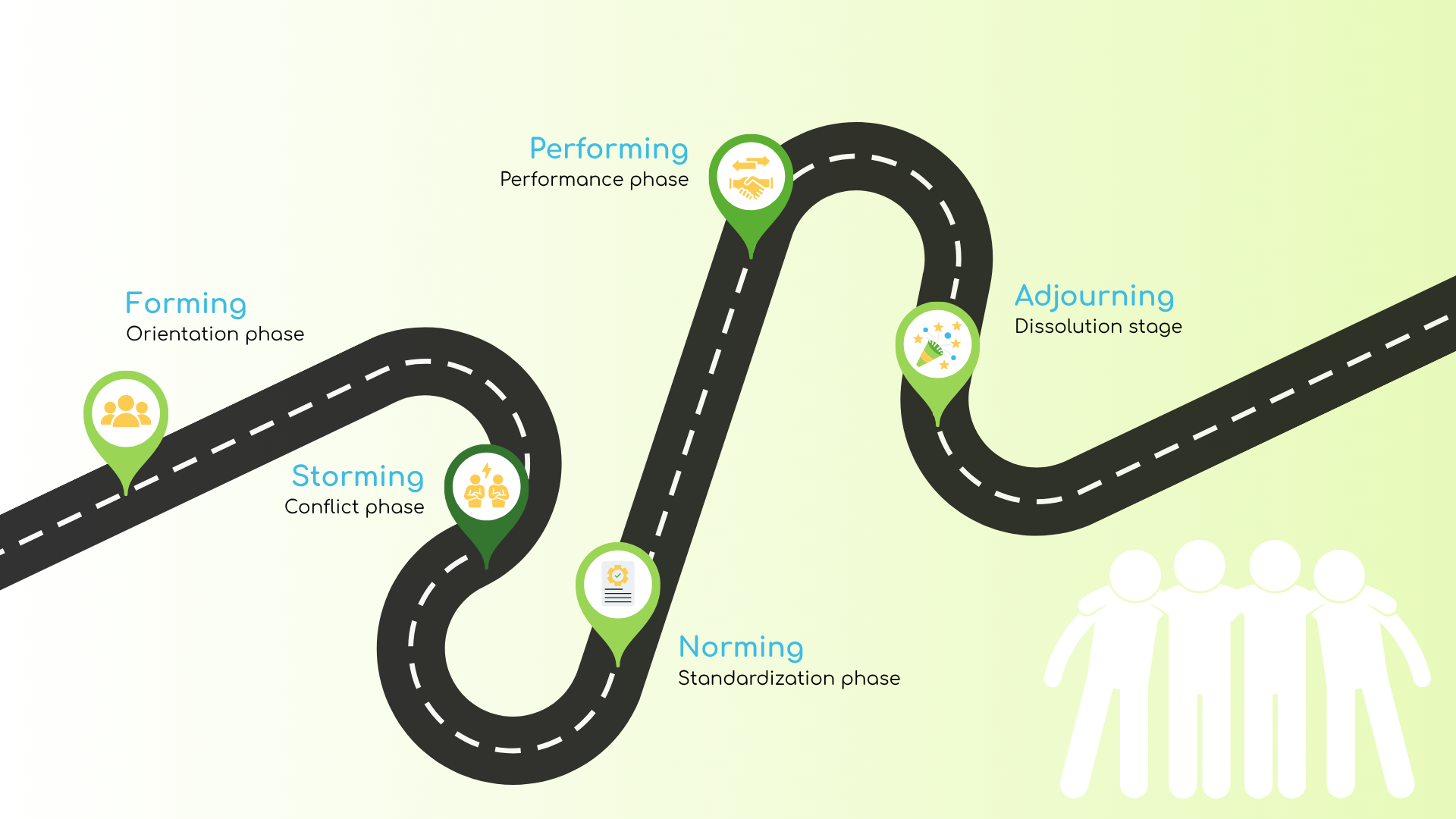Phases of Team Building: The Tuckman Model Explained
Team development is the key to successful collaboration in any organization—whether you're leading a small project team or managing a large enterprise. Bruce Tuckman's proven model provides a clear guide to recognizing and leveraging the different phases of team building. In this article, you'll learn how to resolve conflicts constructively, utilize your team members' strengths, and develop a highly productive team dynamic. Why should you keep reading? Because after this, you'll not only understand how group development stages work but also how to practically apply them for you and your team—for example, with innovative tools like procoli for efficient collaboration.
What is Team Development and Why is it Important?
Team development describes the process by which a group of individuals grows into a high-performing team. Team members go through various phases that significantly influence cohesion, role distribution, and the effectiveness of their collaboration. Without targeted team development, a team's potential often remains untapped, misunderstandings and conflicts arise more frequently, and common goals are lost.
Constructive team development is particularly crucial in project management. It helps you identify and strategically use the individual strengths of team members. This not only allows you to achieve goals more efficiently but also fosters a sense of unity and motivation within the team.

Who was Bruce Tuckman and What Makes His Model Special?
In 1965, American psychologist Bruce Tuckman introduced the now world-renowned model of team development. Tuckman realized that teams go through distinct, clearly defined stages before they can collaborate effectively. His Tuckman model is still considered a standard for leaders and team managers who want to guide their team's development purposefully.
The Tuckman model has been a significant framework in team development research since 1965. It describes how teams evolve from initial orientation through conflicts to optimal performance. The five phases—Forming, Storming, Norming, Performing, and Adjourning—reflect typical dynamics you can observe in any team. Especially in today's often digitally-connected work environment, this model offers helpful guidance for consciously steering team processes and improving collaboration.
Source: EPub Bayreuth
Tuckman initially identified four phases (Forming, Storming, Norming, Performing) and later added a fifth (Adjourning). What makes it special is that the model shows you, as a leader or team member, which phase your team is currently in—and what you can do to improve collaboration.
What are the Five Phases of Team Building According to Tuckman?
Tuckman's model describes five group development stages that every team goes through at different speeds: Forming, Storming, Norming, Performing, and Adjourning. Each phase presents its own challenges and opportunities. Knowing these phases helps you recognize typical conflicts, moderate them effectively, and keep the team on track.
Although the Tuckman model is widely used, it is also critically examined in practice and literature. Not every team goes through the phases linearly or completely. Instead, the phases of team building serve as a guide to identify typical challenges and opportunities in teamwork. It remains important to perceive the individual dynamics of your team and react flexibly—as a leader, it is crucial to maintain open communication and address conflicts constructively.
Source: Agile Administration

The Forming Stage: What to Consider in Group Forming?
The Forming stage, also known as the orientation phase, marks the beginning of every team's journey. Here, team members get to know each other, clarify their roles, and begin to understand the goals and tasks. You'll often sense uncertainty in the team as individuals try to find their place. This initial group forming is critical.
Your role as a leader or team manager is to ensure clear goals and open communication. This helps prevent misunderstandings and creates a sense of belonging. In this phase, it's important to recognize and encourage the individual strengths of the members. Use tools like procoli to make tasks transparent and facilitate collaboration.
The Storming Stage: How to Handle Conflicts Constructively?
Now things get interesting: In the Storming stage, or conflict phase, different opinions, work styles, and expectations clash. Conflicts often arise within the team, but they are necessary for the team to develop further.
The rule here is to address conflicts openly and constructively! A leader who provides moderation and clear rules for communication ensures that disagreements do not become a persistent issue. The Storming phase is a trial by fire for the team—but it is also an opportunity to grow together and clarify individual roles.
The Norming Stage: How Cohesion and Team Performance Emerge?
After the storm comes the calm: In the Norming stage, common values, team rules, and a sense of "we" develop. Team members accept their roles, and responsibilities are clearly defined. You can now feel the collaboration becoming increasingly efficient.
Team development in this phase requires open communication and mutual appreciation. Focus on constructive feedback and promote self-organization within the team. The leader primarily acts as a moderator and coach to further enhance team performance.
The Performing Stage: How Does Your Team Become Truly Productive?
In the Performing stage, the team works together optimally. This is where the team's ability to work independently and productively on common goals becomes evident. Roles and tasks are clear, team cohesion is strong, and communication flows smoothly.
As a leader, you can now delegate tasks and focus on strategic topics. The team leadership steps into the background as team members act autonomously and collaboratively. Tools like procoli help ensure that all information and tasks are centrally available, keeping everyone up-to-date—even external partners can be easily integrated without registration.
The Adjourning Stage: How to Successfully Conclude Teamwork?
The Adjourning stage marks the end of the collaboration—for example, after a project is completed or a goal is achieved. The focus is now on securing results, sharing experiences, and giving the team a proper farewell.
Successful team development includes this phase. Reflect on the collaboration with the team members, celebrate successes, and openly discuss areas for improvement. Good moderation helps to shape the farewell constructively and maintain motivation for future projects.
What is the Role of the Team Leader in the Different Phases of Team Building?
The leader is needed in every phase of team development—but the requirements change: In the Forming phase, you are a moderator and provide orientation. During the Storming phase, you are a conflict resolver and set the rules. In the Norming phase, you promote self-organization and team cohesion. During the Performing phase, you delegate and give the team freedom. In the Adjourning phase, you shape the conclusion constructively and appreciatively.
With procoli, you can optimally support task distribution, exchange, and communication within the team, no matter which of the group development stages your team is in.
How procoli Supports Successful Team Development
procoli is a user-friendly solution designed specifically for efficient collaboration within teams and with external partners. You can distribute tasks based on roles and easily integrate external partners via a link—no registration required.
Automated notifications ensure that all team members and partners stay up-to-date. Through the interactive web view, you as a team leader or member can see all tasks, upload and download documents, and discuss directly in the tool. This keeps communication transparent and avoids misunderstandings. procoli supports you in every phase of team development and makes collaboration constructive, efficient, and productive.
Practical Tips for Effective Team Development and Collaboration
- Identify which of the phases of team building your team is in.
- Promote open communication and constructive feedback.
- Establish clear role and task distribution.
- Use tools like procoli for transparent collaboration and effective project management.
- Accept conflicts as an opportunity for development and guide your team through the Storming phase.
- Support self-organization in the Norming and Performing phases.
- Reflect on the collaboration with the team after the project ends.
- Always focus on the individual strengths of the team members.
- Seamlessly integrate external partners into the workflow—procoli makes it possible.
- Celebrate successes and strengthen the sense of unity.
Conclusion: What to Take Away from the 5 Phases of Team Building by Tuckman
Team development is a process that includes various group development stages: Forming, Storming, Norming, Performing, and Adjourning. Each phase has typical challenges—recognize them and use them to improve collaboration. Conflicts are part of it! The team only grows together through open communication and constructive moderation. The leader guides the team, promotes self-organization, and maintains focus on the common goals. Tools like procoli facilitate collaboration, make tasks transparent, and easily integrate external partners. In the end, what counts is the sense of belonging, productive cooperation, and achieving common goals.
Remember:
Team development is an active process. Understand the five phases of team building according to the Tuckman model. Rely on clear communication and constructive conflict resolution. Use modern tools like procoli for efficient collaboration. Strengthen individual strengths and team cohesion. Celebrate successes and learn from challenges—this is how your team's performance will grow sustainably!